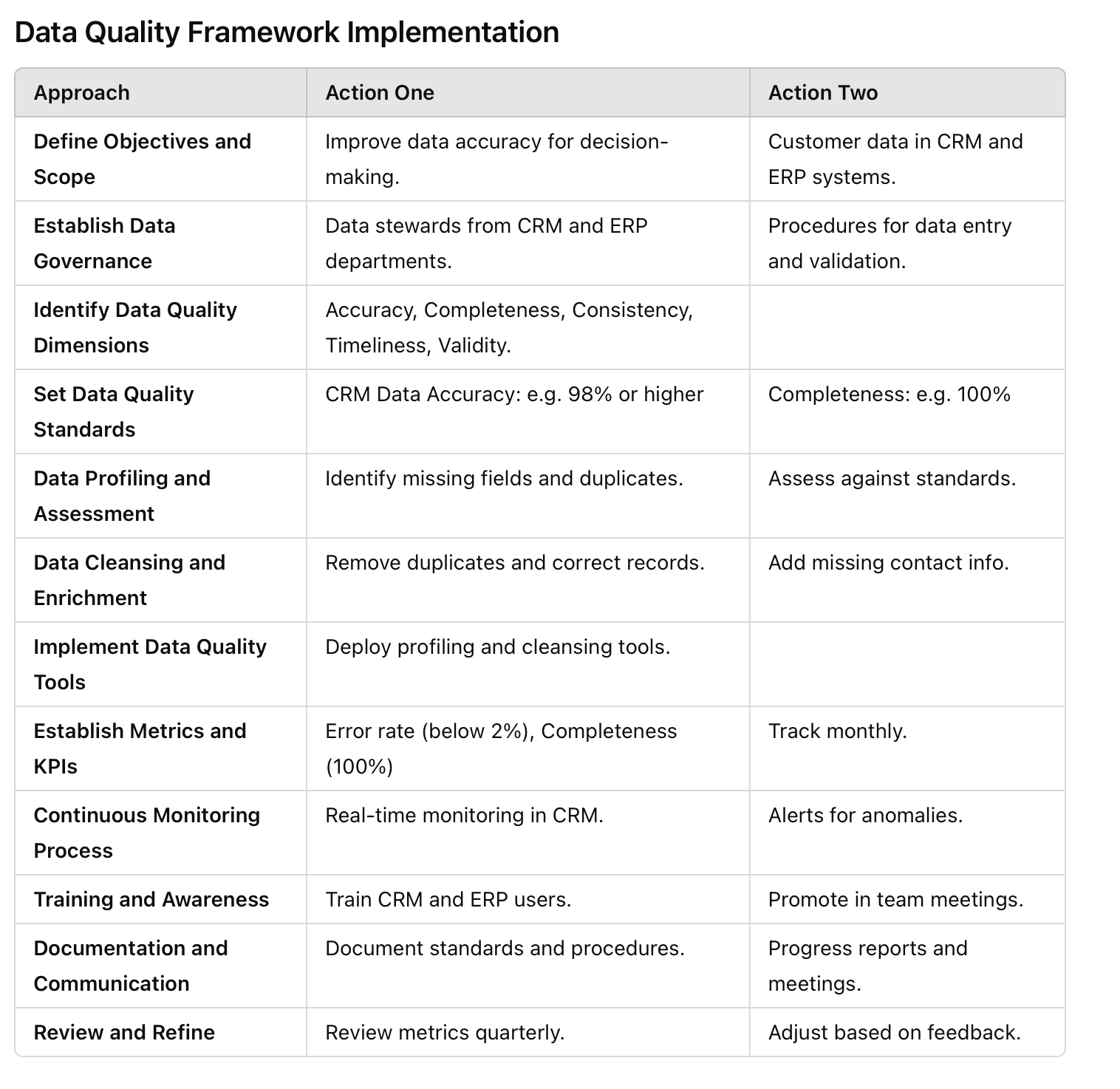What is a Data Quality Framework? How do I implement a Data Quality Framework | Developing a data quality framework
Everything you need to know: what is a data quality framework - why businesses use them? Developing a data quality framework, along with a step-by-step how to guide.
What is a data quality framework?
Organisations use a data quality framework to structure the guidelines, processes, tools and standards that will ensure the accuracy, completeness, consistency, timeliness and reliability of their data.
It provides an approach to managing and improving data quality across various data sources and systems - allowing you to trust your data and support better decision-making and operational efficiency.
Let’s break down the core elements involved in creating a data quality framework for your business.
Developing a Data Quality Framework
Let’s break down the core elements involved in creating a data quality framework for your business.
Data Governance: Establishes policies, roles, responsibilities, and procedures for managing data assets. Ensures accountability and oversight of data quality across the organisation.
Data Quality Dimensions: Defines the specific attributes of data quality, such as accuracy, completeness, consistency, timeliness, and validity. Provides a clear standard for measuring and assessing data quality.
Data Quality Standards: Sets benchmarks and criteria for what constitutes high-quality data. Aligns these standards with business goals and regulatory requirements.
Data Quality Assessment: Involves regular data profiling, auditing, and monitoring to identify data quality issues. Uses statistical and analytical techniques to assess the quality of data.
Data Cleansing and Enrichment: Applies processes to correct errors, remove duplicates, and fill in missing values. Enhances data by adding relevant external information or refining existing data.
Data Quality Tools: Uses specialised software and technologies to automate data quality tasks. Includes tools for data profiling, cleansing, matching, and monitoring.
Data Quality Metrics and KPIs: Defines key performance indicators to measure data quality over time. Tracks these metrics to monitor the effectiveness of data quality initiatives.
Continuous Improvement: Implements feedback loops to refine data quality processes and standards. Encourages ongoing assessment and enhancement of data quality practices.
Training and Awareness: Educates employees on the importance of data quality and best practices. Fosters a culture of data quality within the organisation.
Documentation and Communication: Maintains thorough documentation of data quality policies, procedures, and standards. Regularly communicates data quality goals, progress, and achievements to stakeholders.
The Strategy: How to implement a Data Quality Framework
Implementing a data quality framework involves several steps to ensure data is accurate, complete, consistent, timely, and reliable. Here’s a step-by-step process to guide you.
Here’s an example of how we would implement a data quality framework for our client, to improve their data quality. Ultimately leading to more reliable insights and better decision-making!

Step 1. Define Objectives and Scope
Objectives: Clearly define what you aim to achieve with the data quality framework (e.g., improving decision-making, regulatory compliance).
Scope: Identify which data sets, systems, and processes will be included.
Step 2. Data Governance
Data Governance Team: Form a team responsible for overseeing data quality initiatives, including data stewards and data owners.
Policies and Procedures: Develop and document policies and procedures for data management and quality control.
Step 3. Identify Data Quality Dimensions
Accuracy: Correctness of the data.
Completeness: Ensuring all necessary data is present.
Consistency: Uniformity of data across different systems.
Timeliness: Data is up-to-date and available when needed.
Validity: Data conforms to the defined formats and standards.
Step 4. Set Data Quality Standards
Define benchmarks and criteria for high-quality data, aligned with business objectives and regulatory requirements.
Step 5. Data Profiling and Assessment
Data Profiling: Analyse data to understand its structure, content, and quality. Identify anomalies, inconsistencies, and errors.
Assessment: Evaluate current data quality against defined standards to identify gaps and areas for improvement.
Step 6. Data Cleansing and Enrichment
Cleansing: Correct identified errors, remove duplicates, and fill in missing values.
Enrichment: Enhance data by adding relevant external information or refining existing data.
Step 7. Implement Data Quality Tools
Choose and deploy tools for data profiling, cleansing, matching, and monitoring. Ensure these tools can integrate with existing systems.
Step 8. Establish Data Quality Metrics and KPIs
Define key performance indicators (KPIs) to monitor data quality. Examples include error rates, completeness percentage, and data freshness. Regularly track these metrics to evaluate the effectiveness of data quality initiatives.
Step 9. Develop a Continuous Monitoring Process
Implement automated monitoring systems to continuously check data quality in real-time. Set up alerts and notifications for data quality issues to enable prompt action.
Step 10. Training and Awareness
Conduct training sessions for employees on data quality principles, best practices, and the importance of data quality. Foster a culture of data quality by promoting awareness and accountability among all stakeholders.
Step 11. Documentation and Communication
Maintain detailed documentation of data quality policies, procedures, standards, and metrics. Regularly communicate data quality goals, progress, and achievements to all relevant stakeholders.
Step 12. Review and Refine
Periodically review the data quality framework to identify areas for improvement. Refine processes, standards, and tools based on feedback and evolving business needs.
By implementing a robust data quality framework, organisations can effectively manage their data assets, leading to more reliable insights, better decision-making, and overall improved business performance.
Benefits of using a Data Quality Framework
While it’s easy to understand the importance of accurate and reliable data, there’s more than meets the eye when it comes to the benefits from having a robust data quality framework in place:
- Improved Decision-Making: Ensures that decisions are based on accurate and reliable data.
- Operational Efficiency: Reduces errors and redundancies, leading to more efficient processes.
- Regulatory Compliance: Helps meet legal and regulatory data requirements.
- Enhanced Customer Satisfaction: Provides high-quality data that improves customer interactions and trust.
- Cost Savings: Reduces costs associated with poor data quality, such as rework and lost opportunities.






